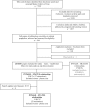Effect of zinc intake on serum/plasma zinc status in infants: a meta-analysis
- PMID: 23647725
- PMCID: PMC6860590
- DOI: 10.1111/mcn.12045
Effect of zinc intake on serum/plasma zinc status in infants: a meta-analysis
Erratum in
-
Erratum.Matern Child Nutr. 2015 Oct;11(4):1056. doi: 10.1111/mcn.12212. Matern Child Nutr. 2015. PMID: 26417897 Free PMC article. No abstract available.
Abstract
A systematic review and meta-analysis of available randomised controlled trials (RCTs) was conducted to evaluate the effect of zinc (Zn) intake on serum/plasma Zn status in infants. Out of 5500 studies identified through electronic searches and reference lists, 13 RCTs were selected after applying the exclusion/inclusion criteria. The influence of Zn intake on serum/plasma Zn concentration was considered in the overall meta-analysis. Other variables were also taken into account as possible effect modifiers: doses of Zn intake, intervention duration, nutritional status and risk of bias. The pooled β of status was 0.09 [confidence interval (CI) 0.05 to 0.12]. However, a substantial heterogeneity was present in the analyses (I(2) = 98%; P = 0.00001). When we performed a meta-regression, the effect of Zn intake on serum/plasma Zn status changed depending on the duration of the intervention, the dose of supplementation and the nutritional situation (P ANCOVA = 0.054; <0.001 and <0.007, respectively). After stratifying the sample according to the effect modifiers, the results by duration of intervention showed a positive effect when Zn intake was provided during medium and long periods of time (4-20 weeks and >20 weeks). A positive effect was also seen when doses ranged from 8.1 to 12 mg day(-1). In all cases, the pooled β showed high evidence of heterogeneity. Zn supplementation increases serum/plasma Zn status in infants, although high evidence of heterogeneity was found. Further standardised research is urgently needed to reach evidence-based conclusions to clarify the role of Zn supplementation upon infant serum/plasma Zn status, particularly in Europe.
© 2013 John Wiley & Sons Ltd.
Conflict of interest statement
The authors declare that they have no conflicts of interest.
Figures
Similar articles
-
Effect of zinc intake on mental and motor development in infants: a meta-analysis.Int J Vitam Nutr Res. 2013;83(4):203-15. doi: 10.1024/0300-9831/a000161. Int J Vitam Nutr Res. 2013. PMID: 25008010
-
Effect of Zinc Intake on Growth in Infants: A Meta-analysis.Crit Rev Food Sci Nutr. 2016;56(3):350-63. doi: 10.1080/10408398.2013.802661. Crit Rev Food Sci Nutr. 2016. PMID: 25365524
-
Effectiveness and safety of vitamin D in relation to bone health.Evid Rep Technol Assess (Full Rep). 2007 Aug;(158):1-235. Evid Rep Technol Assess (Full Rep). 2007. PMID: 18088161 Free PMC article.
-
The relationship between zinc intake and serum/plasma zinc concentration in adults: a systematic review and dose-response meta-analysis by the EURRECA Network.Br J Nutr. 2012 Dec 14;108(11):1962-71. doi: 10.1017/S0007114512004382. Br J Nutr. 2012. PMID: 23244547
-
Selenium for preventing cancer.Cochrane Database Syst Rev. 2018 Jan 29;1(1):CD005195. doi: 10.1002/14651858.CD005195.pub4. Cochrane Database Syst Rev. 2018. PMID: 29376219 Free PMC article.
Cited by
-
Erratum.Matern Child Nutr. 2015 Oct;11(4):1056. doi: 10.1111/mcn.12212. Matern Child Nutr. 2015. PMID: 26417897 Free PMC article. No abstract available.
-
Zinc supplementation for the promotion of growth and prevention of infections in infants less than six months of age.Cochrane Database Syst Rev. 2020 Apr 8;4(4):CD010205. doi: 10.1002/14651858.CD010205.pub2. Cochrane Database Syst Rev. 2020. PMID: 32266964 Free PMC article.
-
What Approaches are Most Effective at Addressing Micronutrient Deficiency in Children 0-5 Years? A Review of Systematic Reviews.Matern Child Health J. 2019 Jan;23(Suppl 1):4-17. doi: 10.1007/s10995-018-2527-9. Matern Child Health J. 2019. PMID: 29868936 Free PMC article. Review.
-
Zinc intake, status and indices of cognitive function in adults and children: a systematic review and meta-analysis.Eur J Clin Nutr. 2015 Jun;69(6):649-61. doi: 10.1038/ejcn.2015.60. Epub 2015 Apr 29. Eur J Clin Nutr. 2015. PMID: 25920424
References
-
- Ashwell M., Lambert J.P., Alles M.S., Branca F., Bucchini L., Brzozowska A. et al; EURRECA Network (2008) How we will produce the evidence‐based eurreca toolkit to support nutrition and food policy. European Journal of Nutrition 47, 2–16. - PubMed
-
- Baer M.T., King J.C., Tamura T., Margen S., Bradfield R.B., Weston W.L. et al (1985) Nitrogen utilization, enzyme activity, glucose intolerance and leukocyte chemotaxis in human experimental zinc depletion. The American Journal of Clinical Nutrition 41, 1220–1235. - PubMed
-
- Ba Lo N., Aaron G.J., Hess S.Y., Guiro A.T., Wade S. & Brown K.H. (2011) Plasma zinc concentration increases within 2 weeks in healthy Senegalese men given liquid supplemental zinc, but not zinc‐fortified wheat bread. The Journal of Nutrition 141, 1369–1374. - PubMed
-
- Bates C.J., Evans P.H., Dardenne M., Prentice A., Lunn P.G., Northrop‐Clewes C.A. et al (1993) A trial of zinc supplementation in young rural Gambian children. The British Journal of Nutrition 69, 243–255. - PubMed
-
- Berger J., Ninh N.X., Khan N.C., Lien D.K., Trung N.Q. & Khoi H.H. (2006) Efficacy of combined iron and zinc supplementation on micronutrient status and growth in Vietnamese infants. European Journal of Clinical Nutrition 60, 443–454. - PubMed
Publication types
MeSH terms
Substances
LinkOut - more resources
Full Text Sources
Other Literature Sources
Medical



